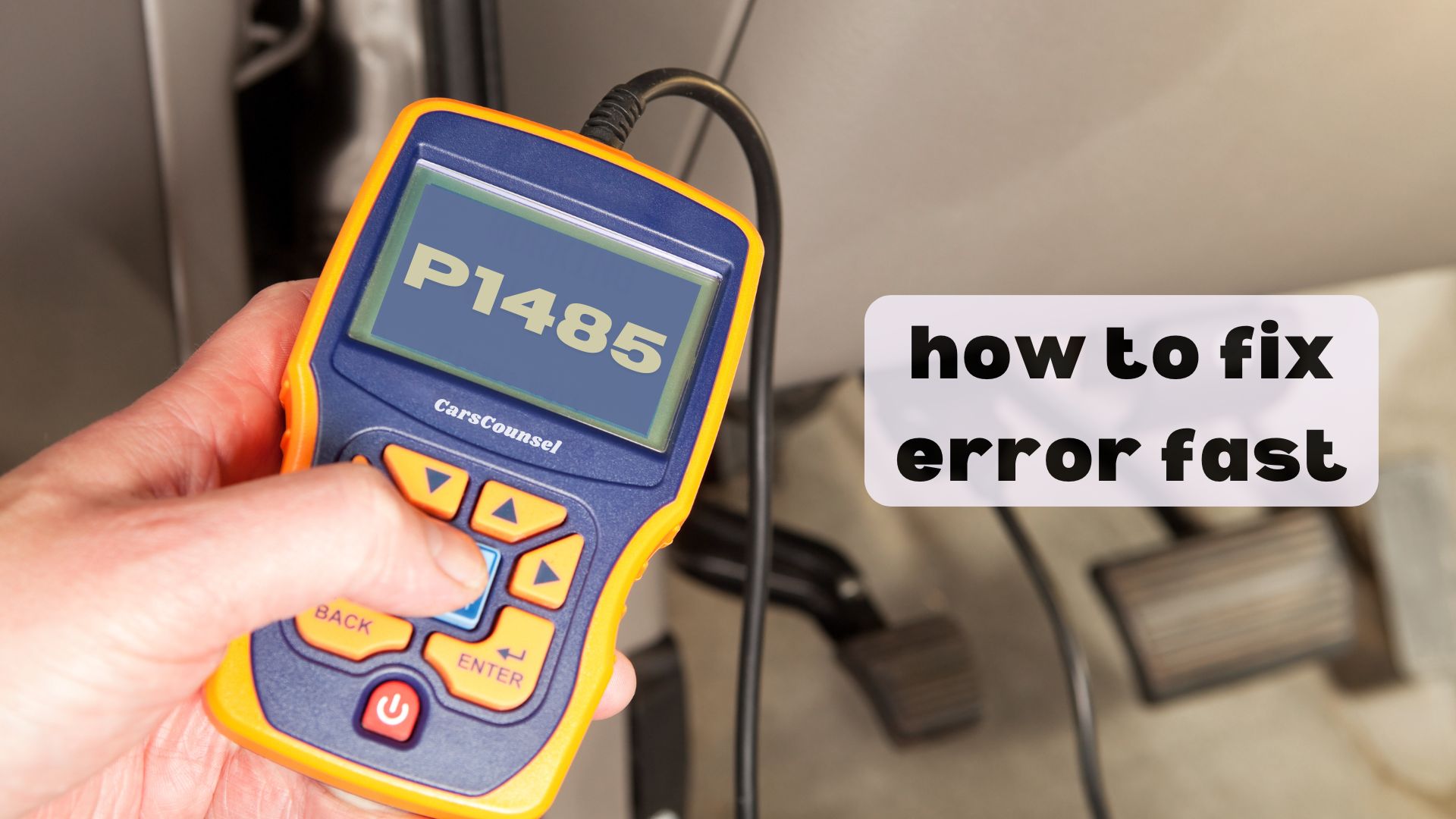If your vehicle’s onboard computer has flagged a P1485 code, it’s alerting you to a critical issue with the engine gas recirculation (EGR) valve circuit. This malfunction can significantly impact your engine’s performance, fuel efficiency, and emissions control. You may notice decreased power, rough idling, and poor acceleration, but ignoring this code can lead to more severe engine damage down the line. It’s essential to investigate the root cause of this issue, which could be a faulty EGR valve, wiring problems, or carbon buildup in the system – and take prompt action to rectify it.

Quick Navigation
Key Takeaways
- The P1485 code indicates a malfunction in the engine gas recirculation (EGR) valve circuit, affecting engine performance, fuel efficiency, and emissions control.
- Common causes of the code include a faulty EGR valve, wiring issues, carbon buildup, and vacuum leaks in the EGR system.
- Symptoms of the P1485 code include the Check Engine Light, rough idling, reduced fuel efficiency, engine knocking sounds, and failed emissions testing.
- To repair the code, diagnose the issue with a scan tool, inspect and clean or replace the EGR valve, and clear the code from the vehicle’s computer.
- Regular maintenance, including oil changes and filter replacements, can help prevent future EGR valve circuit malfunctions and P1485 codes.
Code P1485 Description
The P1485 code indicates a malfunction in the engine gas recirculation (EGR) valve circuit, which is a critical component of your vehicle’s emissions control system.
This system helps reduce nitrogen oxide emissions by recirculating a portion of the exhaust gases back into the engine cylinders.
When the EGR valve circuit malfunctions, it can lead to issues with engine performance, fuel efficiency, and emissions control, resulting in decreased power, rough idling, poor acceleration, and increased exhaust emissions.
If left unaddressed, the malfunctioning EGR valve can eventually lead to engine damage and failure.
Common Causes of P1485
Faulty EGR valves are a leading cause of the P1485 code, and you should suspect a malfunctioning valve if you’re experiencing issues with your engine’s performance.
Wiring issues can also trigger this error code, so inspect the EGR valve circuit for damaged or corroded wiring. Additionally, faulty components, such as a malfunctioning exhaust gas recirculation sensor, can contribute to the problem.
Carbon buildup in the EGR system and vacuum leaks can also cause the P1485 code. By identifying and addressing these common causes, you can diagnose and repair the issue efficiently.
Symptoms of P1485
When your vehicle’s engine gas recirculation valve circuit malfunctions, you’ll likely notice some telltale signs.
The Check Engine Light will illuminate on your dashboard, indicating a problem. You may experience rough idling or stalling, which can affect your vehicle’s performance.
Additionally, you’ll notice reduced fuel efficiency, as the malfunctioning EGR valve circuit disrupts the engine’s combustion process. You might also hear engine knocking or pinging sounds, and your vehicle may fail emissions testing due to increased emissions.
These symptoms will persist until you address the underlying issue, so it’s essential to diagnose and repair the problem promptly.
How to Fix P1485
Now that you’re aware of the symptoms of a malfunctioning engine gas recirculation valve circuit, it’s time to tackle the repair.
Use a scan tool to diagnose the issue and identify the specific cause. Inspect the EGR valve, wiring, and connections for damage or corrosion.
Clean or replace the EGR valve and clear any carbon buildup in the system. Test the EGR system to verify proper functioning and clear the code from the vehicle’s computer.
Cost to Fix P1485
The cost to fix a malfunctioning engine gas recirculation valve circuit, denoted by the P1485 code, can vary depending on the extent of the repair.
You’ll need to weigh repair estimates and budget considerations when planning to fix this issue.
- Labor costs: The time it takes to diagnose and repair the issue can range from 1-5 hours, depending on the complexity of the problem.
- Parts costs: Replacing the EGR valve or other components can add up to $100-$300 to your total bill.
- Diagnostic fees: Additional diagnostic time may be required to identify the root cause of the issue, adding to your overall cost.
Plan accordingly to guarantee you’re prepared for the financial investment required to fix your P1485 code.
Understanding the EGR System
Your vehicle’s engine relies on the exhaust gas recirculation (EGR) system to reduce nitrogen oxide emissions, a key contributor to air pollution.
The EGR system recirculates a portion of the exhaust gases back into the engine cylinders, which helps reduce emissions and improve engine performance.
Recirculating exhaust gases back into engine cylinders reduces emissions and boosts performance.
By doing so, it provides several EGR benefits, including reduced nitrogen oxide emissions, improved fuel efficiency, and decreased engine knocking or pinging sounds.
The EGR system plays a vital role in emissions reduction, making it an essential component of your vehicle’s engine.
EGR Valve Function and Failure
Faulty EGR valve operation can trigger the P1485 code, so it’s essential to understand how this critical component functions and fails.
The EGR valve regulates exhaust gas recirculation, redirecting a portion of the exhaust flow back into the engine cylinders to reduce nitrogen oxide emissions.
When functioning correctly, it helps maintain peak engine performance and emissions control.
- Proper Exhaust Flow: The EGR valve verifies the right amount of exhaust gases are recirculated, preventing excessive flow that can lead to engine knocking or pinging.
- Electrical Signal: The EGR valve relies on an electrical signal from the engine computer to open and close, controlling the flow of exhaust gases.
- Carbon Buildup: Over time, carbon deposits can accumulate on the EGR valve, restricting its movement and leading to malfunction.
Diagnosing the P1485 Code
Diagnosing the P1485 code requires a systematic approach to identify the root cause of the engine gas recirculation valve circuit malfunction. You’ll need to use a scan tool to verify the code and identify the specific cause. Next, perform engine testing to isolate the issue. Check the EGR valve, wiring, and connections for damage or corrosion. Inspect the system for vacuum leaks or carbon buildup.
| Diagnostic Step | Description | Tools Needed |
|---|---|---|
| Verify P1485 code | Use a scan tool to confirm the code | Scan tool |
| Perform engine testing | Isolate the issue using engine testing | Scan tool, engine testing equipment |
| Inspect EGR valve and wiring | Check for damage or corrosion | Multimeter, wiring diagram |
| Inspect system for vacuum leaks | Check for leaks in the EGR system | Vacuum gauge, smoke tester |
Repairing the EGR Valve Circuit
One common repair for the P1485 code is replacing the EGR valve, which can be a relatively straightforward process if you have the right tools and a basic understanding of engine mechanics.
Replacing the EGR valve is a relatively straightforward fix for the P1485 code, requiring basic engine knowledge and tools.
Before starting the repair, it’s essential to consult the EGR Circuit Diagram and EGR System Diagram to understand the components involved.
- Locate the EGR valve, usually found on the intake manifold or engine block.
- Disconnect the electrical connector and vacuum hoses from the valve.
- Remove the valve from its mounting bracket and replace it with a new one.
Remember to follow proper installation procedures to certify the new valve functions correctly.
Preventing Future EGR Malfunctions
Now that you’ve replaced the EGR valve, it’s time to focus on preventing future malfunctions.
Regular maintenance is key to avoiding another EGR valve circuit malfunction. Make sure to follow the recommended maintenance schedule for your vehicle, including regular oil changes and filter replacements.
Additionally, consider taking preventive measures such as using fuel additives to reduce carbon buildup in the EGR system.
More OBD-II Codes
| P1486 | P1291 | P1292 | P1293 |
| P1294 | P1226 | P1209 | P1210 |
| P1204 | P1202 | P1203 | P1198 |
| P1146 | P1145 | P1144 | P1143 |
| P1142 | P1140 | P1139 | P1141 |
| P1138 | P1137 | P1222 | P1221 |
Frequently Asked Questions
Can I Drive My Car With a P1485 Code?
You shouldn’t drive your car if you’re experiencing symptoms like rough idling or stalling, as it can compromise driving safely and roadworthiness. Addressing the issue promptly is vital to prevent further engine damage and guarantee a safe driving experience.
Will a Faulty EGR Valve Cause Engine Damage?
You’re wondering if a faulty EGR valve will cause engine damage. Yes, it can, as carbon buildup accumulates, leading to increased engine knocking, pinging, and eventual failure if left unaddressed, so prompt repair is vital to prevent long-term engine harm.
Can I Clean the EGR Valve Instead of Replacing It?
Think of your EGR valve like a clogged artery – cleaning it can help restore valve functionality, but if EGR deposits are severe, replacement is often the better choice to guarantee peak performance and prevent further issues.
Will a P1485 Code Affect My Car’s Warranty?
You’re wondering if a P1485 code will affect your car’s warranty. The answer is, it depends on the warranty terms and manufacturer liability. If the issue is deemed a manufacturing defect, you may be covered, but if it’s due to wear and tear or maintenance neglect, you might be on the hook.
Can I Fix the P1485 Code Myself or Do I Need a Mechanic?
Get ready to roll up your sleeves! You can attempt DIY troubleshooting, but if you’re not comfortable with electrical systems, it’s best to consult a mechanic to diagnose and fix the issue, ensuring a precise and concise repair.
Conclusion
You’ve got the power to fix the P1485 code and restore your engine’s performance, fuel efficiency, and emissions control. You’ve diagnosed the issue, cleaned or replaced the EGR valve and wiring, and tested the system. Now, drive away with confidence, knowing you’ve prevented engine damage and failure. By staying on top of EGR maintenance, you’ll avoid future malfunctions, ensuring a smoother, more efficient ride.

